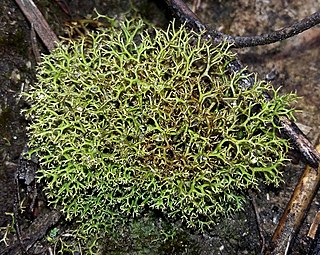
The Roccellaceae are a family of mostly lichen-forming fungi in the order Arthoniales, circumscribed by the French botanist François Fulgis Chevallier in 1826. Species in the family exhibit various growth forms, including crustose and fruticose thalli, and diverse reproductive structures. Roccellaceae species typically have apotheciate or lirellate ascomata, often with distinct blackened margins. Molecular phylogenetics studies have revealed significant genetic diversity and complex evolutionary histories within the family.

Ochrolechia is a genus of crustose lichens in the family Ochrolechiaceae. These lichens typically form uneven, often thick, crust-like growths on various surfaces and are characterised by their white to pale grey thalli, which may have a greenish tint. The genus has a long evolutionary history, with fossils dating back to the Paleogene period, about 34 million years ago. Ochrolechia species have disc-like apothecia, which are usually yellowish or brownish-pink and often covered with a fine white powdery coating. The genus is widely distributed and includes both common and rare species, with some found in extreme environments such as arctic and alpine regions. Ochrolechia lichens produce diverse secondary metabolites, including orcinol depsides, depsidones, and xanthones.

Cladia is a genus of lichen-forming fungi in the family Cladoniaceae. Cladia species have a crustose or squamulose (scaly) primary thallus and a fruticose, secondary thallus, often referred to as pseudopodetium. The type species of the genus, Cladia aggregata, is widely distributed, occurring in South America, South Africa, Australasia and South-East Asia to southern Japan and India. Most of the other species are found in the Southern Hemisphere.

Sarcogyne is a genus of crustose lichens in the family Acarosporaceae. It was circumscribed by German botanist Julius von Flotow in 1850. A proposal has been put forth in 2021 to assign Sarcogyne clavus as the type species of the genus, "as it represents the original concept of Sarcogyne as having melanized lecideine apothecia without algae in the margin".
Septotrapelia is a genus of lichen-forming fungi in the family Pilocarpaceae. It has four species. It was validly published as a genus in 2007 by lichenologists André Aptroot and Jose-Luis Chaves.

Gassicurtia is a genus of lichenized fungi in the family Caliciaceae.

Enterographa is a genus of lichens in the family Roccellaceae.

Lecanographa is a genus of about 40 species of lichens in the family Lecanographaceae. It was circumscribed in 1994 by José M. Egea and Pilar Torrente, with Lecanographa lyncea as the type species.

Roccella is a genus of 23 species of lichens in the family Roccellaceae. The genus was circumscribed by Swiss botanist Augustin Pyramus de Candolle in 1805, with Roccella fuciformis as the type species.
Sclerophyton is a genus of lichen-forming fungi in the family Opegraphaceae. It has about 15 species. The genus was circumscribed by German lichenologist Franz Gerhard Eschweiler in 1824, with Sclerophyton elegans assigned as the type species.

Hypocenomyce is a genus of lichen-forming fungi in the family Ophioparmaceae. Species in the genus grow on bark and on wood, especially on burned tree stumps and trunks in coniferous forest. Hypocenomyce lichens are widely distributed in the northern hemisphere.

Mycoblastus is a genus of crustose lichens in the family Tephromelataceae. Members of the genus are commonly called blood lichens.

Herpothallon is a genus of crustose lichens in the family Arthoniaceae. It has about 50 species.
Angiactis is a genus of crustose lichens of uncertain familial placement in the order Arthoniales. It has four species.

Crocodia is a genus of foliose lichens in the family Peltigeraceae. It has eight species. The genus has a cosmopolitan distribution, although most species occur in temperate and tropical regions of the Southern Hemisphere. The main characteristics of the genus that separate it from its parent genus, Pseudocyphellaria, include a yellow medulla and yellow pseudocyphellae on the lower thallus surface.

Fulvophyton is a genus of lichen-forming fungi in the family Roccellographaceae. It has 11 species. Fulvophyton is characterised by its crust-like thallus, which is often pale yellowish-brown in colour. This genus features a photobiont from the green algal genus Trentepohlia and exhibits a unique arrangement of reproductive structures.
Neosergipea is a genus of lichen-forming fungi in the family Roccellaceae. It has four species, all of which are corticolous (bark-dwelling), crustose lichens that are found in the tropical forests of Brazil. This genus is related to the genera Dichosporidium, Enterographa, and Erythrodecton. It distinguishes itself through unique morphological characteristics and certain chemical constituents, in particular, its non-carbonised ascomata and the presence of a vivid orange anthraquinone compound.
Pallidogramme is a genus of lichen-forming fungi in the family Graphidaceae. It has 8 species of corticolous (bark-dwelling), crustose lichens.
Marchantiana is a genus of lichen-forming fungi in the family Teloschistaceae. It contains seven species of corticolous (bark-dwelling), crustose lichens that occur in the Southern Hemisphere.
Eilifdahlia is a genus of lichen-forming fungi in the family Teloschistaceae. It contains three species of corticolous (bark-dwelling), crustose lichens that occur in the Southern Hemisphere.












